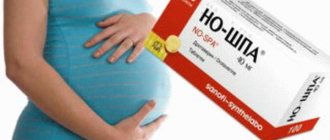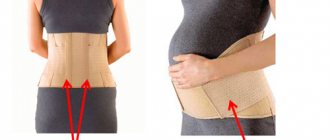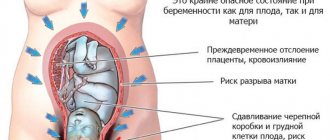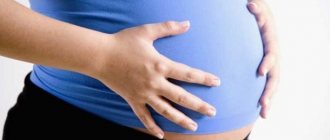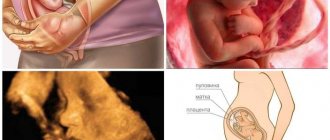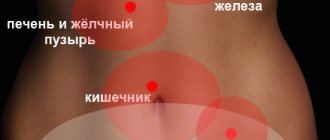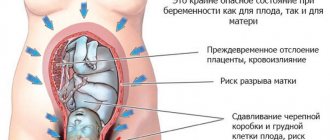There are many reasons why the lower abdomen hurts at 32 weeks of pregnancy. In particular, at this stage of gestation the risk of spontaneous abortion is low, but still not excluded. And then, in addition to nagging pain in the lower abdomen, the woman begins to experience bleeding.
Treatment is aimed at saving the child. Drugs from the category of antispasmodics and hormonal agents are used, and bed rest is required.
The second most dangerous cause is premature placental abruption. It is characterized by severe pain in the lower abdomen and the development of massive bleeding. This indicates rejection of the child's place in the lower segment. When the condition is diagnosed, emergency delivery by cesarean section is recommended.
But pain in the lower abdomen during pregnancy also manifests itself in various pathologies of the gastrointestinal tract. It can be:
- appendicitis;
- colitis;
- proctitis;
- enteritis;
- sigmoiditis
Fetal development at 32 weeks of gestation
- The baby continues to rapidly gain weight, and now his body weight can reach up to 1.8 kg, which naturally affects the weight of the woman herself. The child's height is equivalent to 42 cm.
- At the same time, the fetal nervous system is improved. His brain size is already 60% of the size of an adult human brain.
- Immunity began to work. It produces its own antibodies.
- All endocrine glands also began to work. The pituitary gland, thyroid gland, adrenal glands, and pancreas were activated.
- The child's senses function quite well. He perfectly distinguishes his mother's voice and knows how to distinguish it among common sounds. Therefore, you need to talk to your child as much as possible, you can sing him songs, read fairy tales. At this time, the baby already reacts to light stimuli.
- The child’s appearance undergoes changes - his skin smooths out, wrinkles disappear and fat folds appear, his cheeks become rounded. If earlier the body of the fetus was covered with primordial fluff, now the lanugo is gradually disappearing. In turn, the hair on the head becomes thicker, but at the same time soft.
- The baby occupies the position in the uterus in which it will be born. Head presentation is considered normal.
- The bones of the skeleton become more dense, but the skull is still soft. This will allow the baby to pass through the birth canal more easily.
Problems associated with pregnancy
Risk of miscarriage
Drawing and aching pain in the lower abdomen, as during menstruation during pregnancy, which does not radiate to other areas, can occur when there is a threat of miscarriage. A common accompanying symptom is spotting and spotting. If these signs occur, a woman needs medical attention .
In the future, cramping pain may appear, bleeding will increase and the cervix will shorten, which will lead to miscarriage or premature birth.
The threat of miscarriage with characteristic symptoms can be provoked by:
- infections;
- physical exercise;
- pathologies of fetal development.
Ectopic pregnancy
Sometimes the fertilized egg is located outside the uterine cavity - for example, in the tubes. At 8-12 weeks they may rupture. There are cramping cutting pains on the side of the lower abdomen during pregnancy. Possible irradiation into the anus, under the ribs, into the leg, and the area above the collarbones. The intensity of the pain is so severe that it can cause fainting.
The attacks are short in duration and occur with slight bleeding . However, you should not delay going to the hospital due to the risk of intra-abdominal bleeding. Between attacks, the woman feels normal, but this does not mean that they will not happen again.
Premature placental abruption
Premature placental abruption during pregnancy and childbirth is provoked by a number of factors:
- abdominal injuries;
- shortened umbilical cord;
- severe gestosis;
- arterial hypertension;
- abnormal labor activity.
Due to very severe pain in the lower abdomen during pregnancy, a woman strives to take a position in which they will decrease. There are also signs of fetal hypoxia and internal bleeding, but external bleeding is often absent. During this period, the uterus is painful and tense, and the placental hematoma intensifies. Without timely medical intervention, fetal death is possible.
Feel
A woman’s body works under conditions of increased stress, so the sensations she experiences cannot always be called pleasant. Often, the expectant mother suffers from heartburn and belching, which is associated with pressure from the uterus on the stomach. In addition, the diaphragm becomes compressed, so it is not always possible to take a full breath. Intestinal motility suffers, which can result in constipation.
Training contractions may become more frequent. With their help, the uterus prepares for the upcoming birth.
The baby's movements are very noticeable. Since the baby becomes cramped in the uterus, he stops tumbling, but will work quite actively with his arms and legs. Therefore, you should not be surprised by the sharp pain in the hypochondrium - this baby is kicking mom from the inside.
A woman needs to be attentive to the baby’s movements, counting their total number. Normally, the fetus makes itself known 4-6 times in an hour. It may show increased activity when a woman is excited, when exposed to bright light or loud sounds from the outside.
Future mom
The expectant mother begins to slowly get tired of pregnancy. Due to the displacement of internal organs, you may experience many inconveniences and discomfort. Recommendations for eliminating or reducing them remain the same: minimize salt intake, eat small portions, do not wear tight clothes and shoes, learn to walk, sit and lie correctly. Empty your bladder on time. If you notice that incontinence occurs when coughing or laughing, do not worry - this is a completely physiological phenomenon for your age.
What happens to the belly at 32 weeks of pregnancy?
A woman’s belly at 32 weeks of pregnancy reaches an impressive size and is still growing. The skin on the abdomen tightens, which increases the risk of stretch marks. They can also form on the chest and thighs. To prevent their appearance, you need to use special moisturizers.
Sometimes a dark stripe appears on a woman’s stomach at this stage, running from the navel down. And the navel itself becomes flattened. There is no need to worry about this; after childbirth everything will return to normal.
The following video explains why a woman should start attending courses for expectant mothers from this week. A big belly is not a reason to sit at home. During this period, you need to go to see a doctor every week. Soon the expectant mother will begin to feel strong contractions of the uterus. This means that the body has begun to prepare for childbirth.
Recommendations
At 32 weeks of pregnancy, it is very important to improve your emotional state. Communicate with your child constantly. Not only mom, but also dad needs to talk to the baby and stroke the tummy: the voices and touches of the parents are different, and the baby reacts to them differently.
If you have fears about childbirth, talk to your doctor about it. A specialist will answer all questions, and you will be able to more objectively assess the situation without surrendering to the power of your wild imagination. To save your nerves, try to protect yourself from negative information, do not communicate with overly emotional people and do not watch scary films. Be prepared for the birth to be easy. Fitness or yoga for pregnant women, hobbies, and pleasant meetings with friends will help you take your mind off bad thoughts.
31 - 32 weeks of pregnancy is the time to choose a maternity hospital (many have not done this yet). If you are going to have a contract birth, it is especially important to find a good doctor. Read reviews, or even better, talk to women who have been given birth by the specialist you are interested in. And having chosen an institution, check what things you need to take with you. Each maternity hospital has its own list, but, as a rule, it contains hygiene items and clothes for mother and baby, diapers and much more. It is also necessary to prepare documents: a referral or contract with the maternity hospital, an exchange card, test and ultrasound results, a passport and insurance.
The baby is rapidly gaining weight, so this week it is important to monitor his diet so as not to “feed” him, otherwise injuries will not be avoided during the birth process. No matter how much you want something tasty, avoid eating sweets and starchy foods. Eat in small portions. At 31–32 weeks of pregnancy, you need products that contain magnesium, zinc, iron and vitamin D. During this period, it is recommended to completely exclude pork from the diet, and to remove excess fluid from the body and normalize intestinal motility, it is advisable to drink dried fruit compotes . Tormented by attacks of flatulence? Enter a “moratorium” on legumes, cabbage and rye bread, and also try not to drink 30 minutes before meals and for the same time after.
Starting this week, rest 2 to 3 hours more than before. Avoid infectious and colds, since drug treatment during this period is undesirable. Sex during the 31st – 32nd week of pregnancy is not prohibited and is even necessary (but only in the absence of contraindications), because intimacy is a wonderful way to get emotional release. In addition, during orgasm, the uterus contracts, which means that a kind of prenatal preparation occurs. But keep in mind that semen contains prostaglandins. These biologically active substances help soften the cervix, therefore, in order not to provoke labor, you must use a condom.
Ultrasound at 32 weeks of pregnancy
As a rule, it is at the 32nd week of pregnancy that a woman undergoes her last scheduled ultrasound. It aims to assess the child's growth and development. In addition, the doctor examines the condition of the placenta, its degree of maturity and how well it copes with its functions. If fetoplacental insufficiency is diagnosed, the woman will require treatment.
During an ultrasound, it is possible to accurately determine the presentation of the fetus. If the baby is in a breech or lateral position, the doctor may recommend a set of special exercises to the woman. They will be aimed at making the baby roll over.
The height and weight of the fetus matters. These indicators determine whether a woman can give birth on her own or whether she will need a cesarean section.
What kind of discharge can there be at 32 weeks?
Normally, discharge should be moderate, milky in color, odorless and uniform in consistency. If a woman notices any changes in their character, then this should be a cause for concern.
The following signs may indicate an infection:
- The appearance of leucorrhoea is greenish, yellowish or gray.
- Curdled clots, foam, mucus in the discharge, their unpleasant odor.
- Itching and irritation of the skin of the external genitalia.
An infection at 32 weeks of pregnancy must be treated, but a doctor must prescribe therapy.
If bloody discharge appears, you must call an ambulance as quickly as possible. Bleeding may indicate such serious complications as placental abruption and the onset of premature labor. Only a specialist can clarify what exactly caused the appearance of blood in the discharge.
Watery discharge, which can be abundant or scanty, should not be ignored. Such discharge indicates leakage or rupture of amniotic fluid. In both cases, emergency hospitalization is required. Leakage of water occurs when the fetal membrane is defective, which threatens infection of the fetus. Massive discharge of amniotic fluid signals that labor will begin soon.
Dangers at this time
At 32 gestational weeks, the following pathologies can be identified:
- oligohydramnios or polyhydramnios, that is, the amount of amniotic fluid is not normal. The doctor identifies the disease using an ultrasound examination;
- premature aging of the placenta, placental insufficiency;
- entwined with the baby's umbilical cord;
- breech presentation and other types;
- short cervix;
- isthmic-cervical insufficiency;
- gestosis;
- Anemia is very common, so it is important to take iron vitamins;
- Diastasis.
A woman experiences discomfort when walking and physical activity, this is due to the heavy load on the body. At this time, it is better to maintain a moderate lifestyle, do light exercises and wear a bandage.
Signs of premature birth: pain in the lower back, lower abdomen (it becomes stone), diarrhea, outflow of amniotic fluid and spotting from the vagina. In such a situation, you need to urgently seek help from a medical institution.
Causes of pain
Global changes that occur in a woman’s body can lead to painful sensations.
- Pain in the back and lower back is associated with a shift in the center of gravity and increased load on them. To reduce them, you need to monitor your diet, avoid gaining extra pounds, sleep in the correct position (on your side, covered with pillows), control your posture, and perform simple physical exercises.
- Pain in the legs is associated with an increase in a woman’s body weight. To get rid of them, you need to give your lower limbs a rest. It is not recommended to stand or sit for a long time, and you should not cross your legs. As soon as such an opportunity arises, the legs need to be raised to some height - on a small chair, on a pillow, etc. This will improve blood circulation and prevent the occurrence of edema.
- Pain in the chest area can be triggered by the movements of the child, who kicks the mother from the inside with his leg.
- Mild pain in the abdomen, accompanied by tension, indicates training contractions.
Swelling of the arms and legs is a phenomenon very typical for the 32nd week of pregnancy. Normally, swelling is small and goes away very quickly. To prevent their appearance, you need to take short walks, engage in physical exercise, and perform exercises for pregnant women. It is very good if you have the opportunity to visit the pool. Water aerobics allows you to relieve stress on your back and legs, increase blood circulation and reduce swelling.
If you are prone to edema, you need to limit your salt intake and monitor the amount of fluid you drink. However, you cannot completely remove salt from your diet.
It is important to immediately consult a doctor if swelling does not go away for more than a day. They may indicate a serious pregnancy complication such as gestosis.
Pain not associated with pregnancy
Digestive disorders
Due to hormonal changes, expectant mothers often suffer from bloating, constipation and intestinal dysbiosis. Provoking factors are:
- unhealthy diet;
- a hearty dinner;
- low physical activity.
Digestive disorders often occur in the 2nd half of pregnancy and are accompanied by nagging and aching pain . Nausea with vomiting, heartburn, and belching may be present. In severe cases, there is a risk of miscarriage.
Abdominal muscle and ligament strain
During pregnancy, the uterus grows, which increases the load on the ligaments that support it, and the organs in the pelvis are displaced. At the same time, the load on the abdominal muscles increases, causing them to stretch.
In these conditions, mild aching or stabbing pain . If the stomach is large, an umbilical or linea alba hernia is possible. Towards the end of pregnancy, moderate abdominal pain can provoke separation of the pelvic bones.
Acute surgical pathologies
Pregnant women often develop acute surgical pathologies, including intestinal obstruction, appendicitis, and pancreatitis. Diagnosis is difficult, and symptoms depend on the specific disease. Abdominal pain of varying intensity is observed . With an “acute abdomen”, nausea with vomiting, diarrhea, weakness and high body temperature appear.
How is childbirth at 32 weeks of pregnancy?
Childbirth at 32 weeks of pregnancy is premature, but the survival rate of children born at this period is quite high. The main thing is to seek medical help in a timely manner. Doctors in maternity hospitals have all the necessary equipment to deliver the baby and keep him healthy. However, every effort must be made to ensure that the baby remains in the stomach for another 2 months, because during this time his body undergoes significant changes that are aimed at preparing for the upcoming independent life.
If a woman is pregnant with twins.
Twins are most often born earlier than one child. Sometimes childbirth occurs precisely at the 32nd week of pregnancy, so it is advisable to limit all possible stress in order to ensure that children stay in the mother’s belly for as long as possible.
Pain during training contractions
Everyone has different pain thresholds, so some may find training contractions painful. In such cases, it is recommended to take valerian or another mild sedative. The discomfort is usually short-lived . It goes away when the woman takes a comfortable body position and relaxes.
Intense and prolonged pain during training contractions most often indicates increased uterine tone or a “pathological preliminary period” that occurs before childbirth in emotionally unstable women. It is accompanied by irregular attacks of pain in the lower abdomen and back, which do not lead to childbirth. This condition lasts from 6 hours to 2 days and causes fatigue. Early rupture of water, weak labor and fetal hypoxia are possible, so the woman requires medical attention.
Tips for 32 weeks
- Women often complain of insomnia. You can try to get rid of it by adhering to the following recommendations: ventilate the room before going to bed, take short evening walks, listen to calm music. If your enlarged belly prevents you from getting a good night's sleep, you can purchase a special pillow for pregnant women. Many expectant mothers note that thanks to this device, sleep has become more sound.
- Arranging a room for your unborn child will be a pleasant and useful pastime. You can choose a crib, stroller, furniture, etc. in advance. You should also take care of the clothes for the baby that he will need for the first time.
- It is important to monitor your health. If severe swelling or unusual discharge occurs, you should immediately call a doctor at home.
- It’s good if there is an opportunity to attend a school for future parents. It is advisable to involve the father in such activities, especially if he is planned to be present at the birth.
- Large crowds of people should be avoided, which will reduce the risk of infection with various viral diseases.
What dangers may lie in wait?
- The most dangerous complication of pregnancy that can now arise is late toxicosis (preeclampsia) and placental abruption. The woman must be urgently hospitalized.
- The development of polyhydramnios or oligohydramnios is possible, which requires treatment in a hospital setting.
- Less dangerous conditions include severe swelling, back pain, heartburn, and varicose veins.
- At 32 weeks of pregnancy, premature labor may begin.
